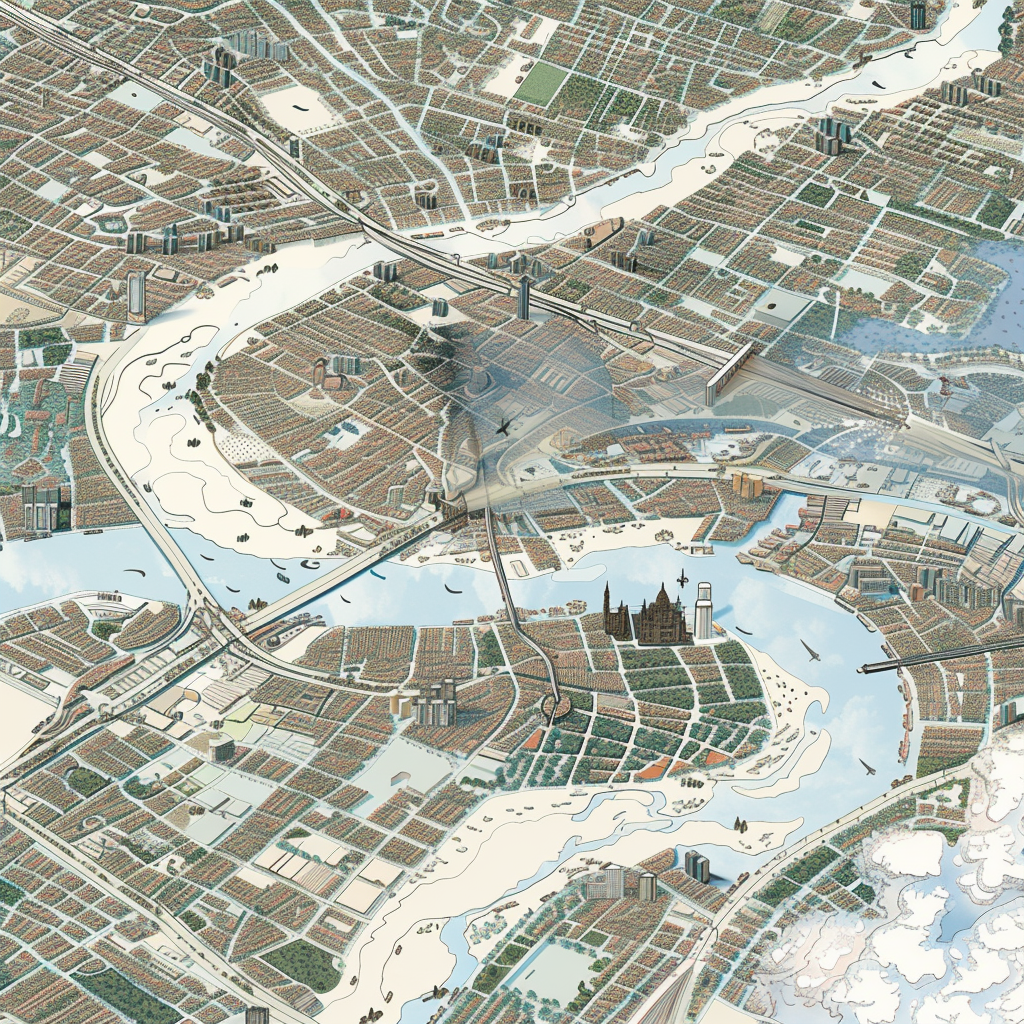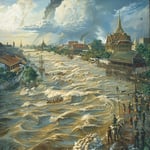Last month, an impressive reinforcement project kicked off near the Niwet Woradit pier by the Chao Phraya River in the bustling heart of Bangkok. Thanks to the sharp eyes and skillful hands orchestrating these efforts, engineered chaos was tamed—for now. But looming large, like a suspenseful scene from a thriller, a new alert from the Royal Irrigation Department has everyone in the lower Chao Phraya River basin, including Greater Bangkok, anxiously checking the skies.
Sitting at the helm of this nerve-racking announcement is Lerboon Udomsap, an engineering connoisseur with a knack for predicting watery disasters. On Sunday, wielding his expertise like a weather-predicting wizard, Mr. Lerboon revealed that torrents from the North are marching south. This watery brigade means a gradual increase at the Chao Phraya barrage in Chai Nat province, where water flow is set to rise from a tranquil 2,150 cubic meters per second to a slightly more anxious 2,400 cubic meters this week.
This might sound like a numerical jest to those safe in their high-and-dry abodes, but for those living alongside Bangkok’s iconic waterways, the stakes couldn’t be higher. As water picks up speed, riverside communities in places such as Sapphaya district of Chai Nat find themselves squarely in the drama’s splash zone, with fears of overflow and deeper floods threatening to turn everyday life into a soggy saga.
The saga’s setting spills over into other picturesque yet precarious locales, like the districts of In Buri, Muang, and Phrom Buri in Sing Buri, and the charming towns of Muang and Pa Mok in Ang Thong. The watery menace also extends its reach to the communities near Phong Pheng and Bang Ban canals, and the Noi River in historically rich Ayutthaya, spreading an involuntary damp welcome to Muang and Sam Khok districts in Pathum Thani.
But the sequel doesn’t end there; about 30 riverside communities in the scenic Muang and Pak Kret districts of Nonthaburi are faced with similar high-water anxieties. Meanwhile, skirting through the concrete jungle, Bangkok itself braces as 32 flood-prone areas, including the Song Wat area, play out their own watery watch.
Should the skies descend with heavy rains and high tides between October 18 and 22, Mr. Lerboon warns that an already precarious situation could flirt with calamity as water levels block free drainage of rainwater. Far from idly sitting back, irrigation officials are battling the elements—heroically attempting to channel water from Greater Bangkok’s veins to the sea via the Tha Chin and Bang Pakong rivers. They aim to clear the passageways, making room for the rain-laden clouds set to loom large later this month.
Adding an unexpected twist comes Surasee Kittimonthon, the voice of gravity at the Office of National Water Resources. Like a surprise character appearance, he brings a relief-soaked update. The torrents from Chiang Mai’s Ping River, which are en route to the Bhumibol dam in Tak province, should behave and not add to the Chao Phraya River’s already brimming panorama. For now, those relying on Bangkok’s intricate dance with water can heave a small sigh of relief.


















This sounds like another round of fearmongering to me. Every year there’s some catastrophe predicted and they never actually happen. Just a way to get more funding for their projects.
But isn’t it better to be prepared than to ignore the warnings? These projects save lives and livelihoods.
I understand the need for caution, but there’s a fine line between being prepared and causing unnecessary panic.
The science behind flood predictions has improved drastically. Lerboon Udomsap’s track record speaks for itself. It’s crucial we take these warnings seriously.
I’m just worried about the people in these riverside communities. Government assistance is often too little, too late.
Exactly, proactive measures are needed now. Local governments should do more than just wait for help from higher up.
It’s really a failure of multiple systems. Community-based solutions could also make a difference.
If they know the dates the high tides will strike, can’t they plan accordingly? It’s not that hard.
Predicting exact outcomes involves numerous complex factors. It’s not as straightforward as you think.
I get that it’s complex, but there seems to be a lack of coordination on the ground every time.
Lerboon Udomsap is the man! If he says a flood is coming, I’d trust him over anyone else.
The numbers don’t lie. An increase in 250 cubic meters per second is not trivial, especially in areas already flood-prone.
Yeah, but it’s still just numbers until you see actual water flowing into your doorstep. Numbers aren’t experiences.
For those of us living near these areas, it feels like we’re being left to the mercy of nature each year.
What can ordinary citizens do, though? We rely on these officials and their guidance.
True, but being informed and having personal plans helps. Sadly, not everyone has that privilege.
And what about climate change? Is anyone even addressing the elephant in the room with these recurrent floods?
Of course, it’s part of the discourse. But immediate action focuses more on mitigation and response.
You’d think more would be done considering it’s a growing threat, but politics get in the way.
I just hate the inevitable traffic jams the rain always brings to Bangkok. A two-hour commute turns into four easily.
You’re focused on traffic, while others worry about their homes getting submerged. Priorities!
Are the neighboring provinces ready to assist if Bangkok gets heavily flooded?
That depends on the level of readiness and resources. Video games and reality are two different things.
Doesn’t it all boil down to money? If they had enough, they’d solve this problem once and for all.
Money is only part of it. Better implementation and governance are key.
Then maybe it’s time for a leadership shake-up. Some fresh ideas could be useful.
Shouldn’t the city look into building better drainage systems rather than just relying on forecasts?
Easier said than done with the density and layout of a city like Bangkok.
It’s amazing how we can predict floods but still struggle to prevent effectively. Perhaps we should channel efforts into innovation rather than tradition.
I wish there was a simpler solution that people could understand easily. It’s all too complex for many to grasp fully.
A big rubber band to keep the water out maybe? Just joking, but sure, easy communication of what’s happening would be good.